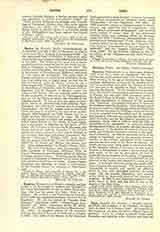

Cano, ALONSO (or ALEXIS), a Spanish painter, architect, and sculptor, b. at Granada, March 19, 1601; d. there 3 or October 5, 1667. He received his first lessons in art from his father, Miguel Cano, an architect. Later he studied sculpture under Juan Montanes, and painting under Pacheco and Juan del Castillo. In 1625, when Herrera, the sculptor, was his teacher, he attained great fame by producing three colored statues, now in the church at Lebrija: “The Virgin and Child”, “St. Peter”, and “St. Paul”. They are all superb pieces of statuary, but the first is a masterpiece, conceived and executed in a noble, classical, simple style that rightly earned for Cano the title of the “Michelangelo of Spain“. Besides his single figures in marble, he chiselled many beautiful retables, or monumental altar-pieces.
Cano went to Madrid in 1637, and through the influence of the Duke of Olivarez and of Velasquez, but chiefly because of his own merit, was made Master of the Royal Works, Painter to the King, and first in rank among the instructors of Don Balthasar Carlos. In Madrid he contributed plans for several palaces, city gates, and a triumphal arch for the entrance of Maria Anna of Austria, wife of Philip IV. In 1650 he became architect of the cathedral of Toledo. Cano was suspected of having murdered his wife, and was unjustly condemned and ordered to leave Madrid. He took refuge in Valencia, attained marked success there, painted a “Nativity”, and a “St. John” for the city’s great church, and entered the Carthusian convent, so as to be able to devote himself wholly to painting, which henceforth occupied him to the exclusion of sculpture. Tardy justice was done him when he returned to Madrid. He was restored to royal favor, but Cano felt that his only surety was in the Church; therefore he took orders and became a resident of Granada. In 1652 Philip IV appointed him a canon in the cathedral of Granada. To the churches of Granada and Malaga he presented many pictures and statues. A councillor of the former city, having ordered a statue of St. Anthony of Padua from Cano, was charged one hundred doubloons, whereat he demurred, saying that the artist was demanding four pistoles per day for twenty-five days’ work, which was more than he, Cano’s superior, could earn. “It has taken fifty years of study to produce this!” cried Cano, hurling the statue to the pavement. For this indignity to a saint he was suspended by the Chapter of Granada. In 1658 the king restored Cano, and required him to complete a crucifix which the queen had ordered.
Cano was a greater sculptor than painter, but he would have attained fame as a painter even had he never worked in marble. His earlier work in color was tentative, eclectic, and of little originality, but his later pictures, which fill the churches of Granada and Malaga, are splendid in drawing, brilliant in a coloring that vividly recalls Van Dyck’s, full of imagination, and bold in design. His flesh tints are pure, the pose of his figures is statuesque, the lines are sharp, vigorous, and classical, and he had a profound knowledge of chiaroscuro. Cano led an exemplary life, his great fault being his ungovernable temper; he was industrious, studious, and very generous. It is related of him that, often, when he had no money for alms he would make a drawing for the beggar to sell. His abnormal antipathy to Jews was exemplified on his deathbed when he refused the Sacrament from a priest who had given it to converted Jews. Among his works mention may be made of: “St. Agnes” (Berlin); “The Dead Christ” (Madrid); “Virgin and Child” (St. Peters-burg); “St. Anthony of Padua” (Munich); “Madonna and Child”, sculpture, in the church of Lebrija (the ancient city of Nebrissa).
LEIGH HUNT

